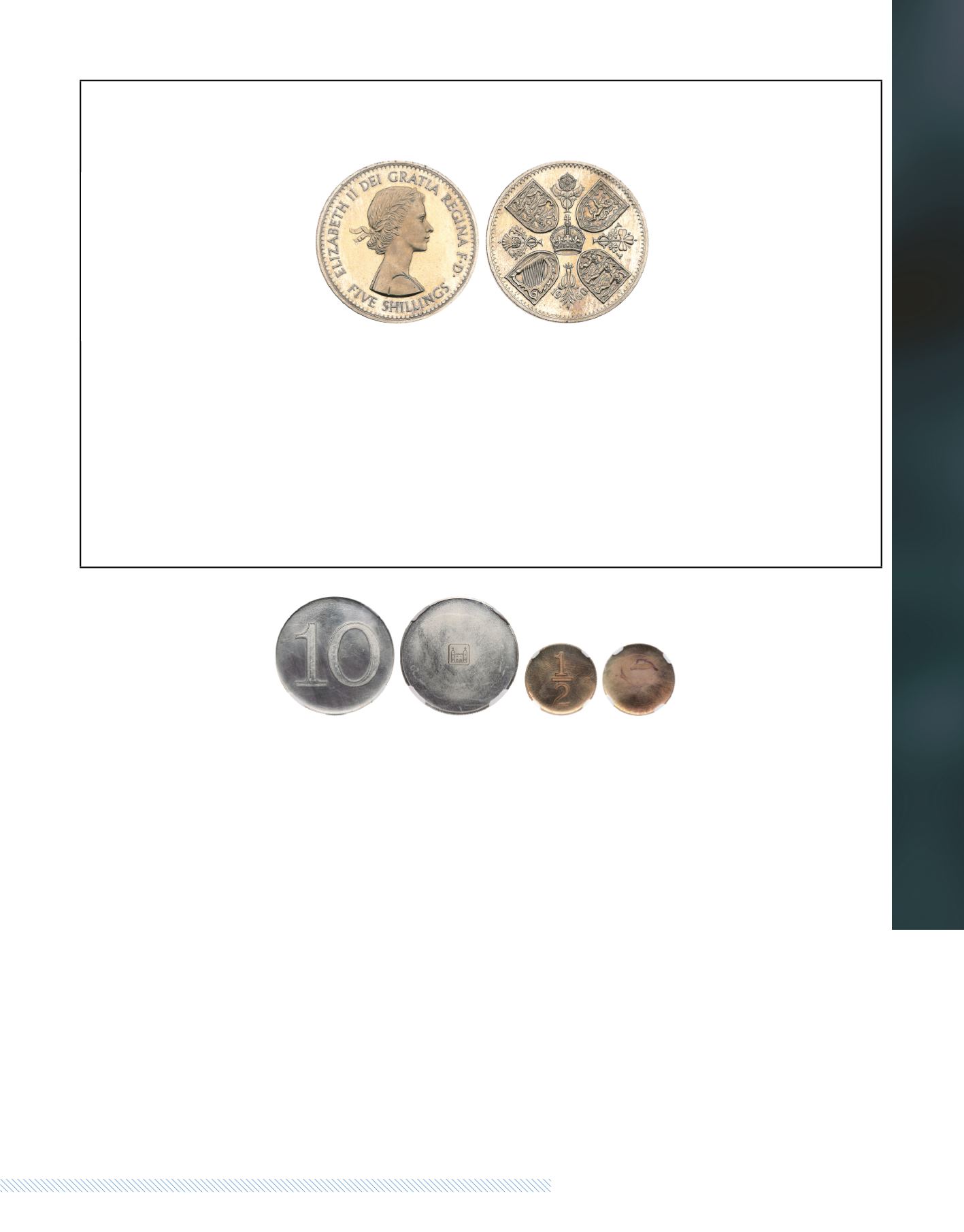

211
bid online at
www.goldbergcoins.com(800) 978-COIN (2646)
|
R
ARE
1960 VIP P
ROOF
C
ROWN
2980
Great Britain. VIP Proof Crown, 1960
. S.4143; ESC-393M (Rarity-4); KM-909. Elizabeth II. Obverse portrait of Queen Elizabeth II ELIZA-
BETH II DEI GRATIA REGINA F: D: FIVE SHILLINGS.' Reverse, cruciform shields of England, Scotland, England and Ireland with emblems, this-
tle, rose, shamrock, and leek. Crown in center, 19 60 below. The obverse and reverse are identical to both the normal currency issue and the
somewhat scarcer polished die variety, but on the VIP specimen the design is frosted and the field highly polished. Superb example.
PCGS
graded Proof 64 Deep Cameo
.
*Linecar and Stone states that a footnote in the 1968 edition of English Silver Coinage points out that the 1960 crown was struck on the occa-
sion of the British Trade Fair in New York and the coins sold at the Exhibition site were struck in the UK from polished dies and exported in spe-
cial blue plastic cases. After the closing of the Exhibition unsold pieces were shipped back to the UK in bags, having been removed from the
cases. In consequence, polished die crowns are very difficult to obtain in perfect state.'
The VIP proofs are considerably rarer than the polished die crowns and ESC rates these as Rarity 4 (11- 20 examples known) The polished die
crowns are merely rated as ' Scarce.'.
Estimated Value .............................................. $1,400 - 1,600
2981 Great Britain. Elizabeth II, Royal Mint, undated (circa 1967-1968) official set of 5 Decimal Trial coins:
. 10 Pence and 5 Pence in
cupro-nickel, 2 Pence, 1 Pence and Half Penny in bronze. Struck by the Royal Mint in advance of the decimalisation process. Obverse, numerals
denoting denomination. Reverse, plain or Royal Mint logo. Excessively rare as a set. Mint state. Sold with a group of the actual first 5 decimal coin
denominations issued.
1968 5 Pence, MS-65, and the 1968 10 Pence NGC graded MS-64; 1971 Halfpenny, Penny and 2 Pence NGC
graded MS-64 Red and Brown; Numeral ½ NGC graded MS 64 Red; Numeral 1 NGC graded MS-63 RB; Numeral 2 NGC graded
MS-64 RB; Numeral 5 NGC graded MS-66; Numeral 10 NGC grade
.
*In 1968, three years before Britain adopted a totally new decimal currency, the Royal Mint produced a set of 5 coins in a blue wallet, to show the
public how the new coinage would look. Although distributed in 1968 the nickel coins were dated 1968, but the 3 bronze coins were post-dated to
1971.
There was a Decimal Currency Board set up, with Chairman Lord Fiske supervising the changeover, and the conversion to decimal currency - prob-
ably the greatest coinage change ever experienced in the United Kingdom - continued gradually over the next three years. Only the 10 Pence, 5
Pence, 2 pence, 1 Penny and ½ Penny were available in 1968, as the 50 Pence coin (to replace the 10 Shilling banknote) was not introduced until
the following year.
The obverse of the new coins featured a portrait of Queen Elizabeth II by Arnold Machin and the reverse designs were by Christopher Ironside.
Before the large numbers of 5-coin wallet sets of coins were produced, the Royal Mint made a few (possibly only 3 or 4) official sets of trial coins,
which replicated the size, weight and metal of the planned currency coins, but had the numerals 10, 5, 2, 1 and ½ in the place of the Queen' s
portrait, to represent the new denominations. These pieces have the correct milled/reeded edges on the nickel pieces and plain edges on the
bronze. The 3 larger pieces have the Royal Mint logo on the reverse.
This set of decimal trials or patterns is an important piece of Britain' s numismatic history.
Estimated Value .....................................................................................................................................................................$1,400 - 1,600



















